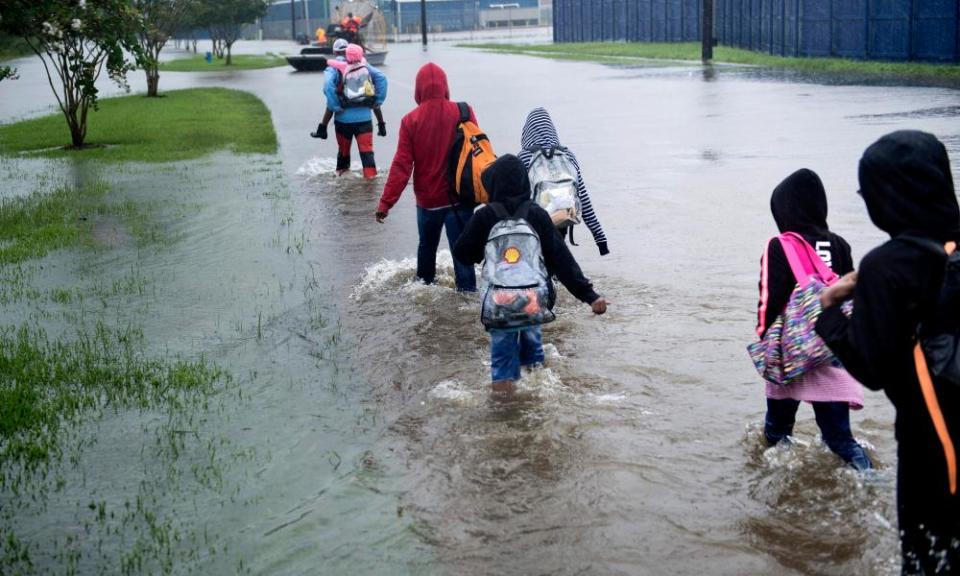Sewage, debris, mosquitoes: flood waters increase health risk for Harvey victims
Flood waters were still pouring into homes in Houston – bringing with them a further threat to public health

Tropical storm Harvey continues to threaten lives in Houston, where officials are focused on evacuating hospitals and securing life-saving emergency transportation, knowing they face long-term health threats.
“Our number one priority now,” said Chris Van Deusen, a clearly frayed spokesperson for the Texas Department of State Health Services, is “to make sure hospital patients and those with medical needs are taken care of.”
Flood water – a nasty cocktail of chemicals, heavy metals, sewage, debris and wildlife – was still pouring into people’s homes on Tuesday. Social media overflowed with images of people being rescued via jet ski, canoe and fishing boat.
Twelve hospitals in the Houston area were evacuated by Tuesday. Some emergency medical services were coming back online in Corpus Christi and Victoria.
“Aside from just the general public health functions, we also help coordinate medical transportation, assisting and coordinating and evacuating hospitals,” said Van Deusen. “We have been moving ambulances, ambulance buses, and we’re staging some helicopters,” he said.
Public health researchers who focus on long-range impacts watched the catastrophe with disbelief. Before the flood, Houston already had problems. Flood waters seemed to only exacerbate potential dangers.
“Words just can’t describe it,” said Garrett Sansom, an environmental health scientist at Texas A&M University. “We’ve been trying to wrap our heads around a unified response as researchers, but also the communities we work with have been hit the hardest.”
Houston was already affected by inequality and healthcare disparities. The Manchester neighborhood in Houston is what Samson described as a “classic environmental justice” area – a Latino neighborhood on the Houston shipping channel where petrochemical plants surround houses and most people speak Spanish.
“Barium is ubiquitous in the area because of refineries, as well as arsenic and mercury,” said Sansom. “All of that is going to be in potential of coming into contact with humans. There’s sort of the complex chemical mixture.”
Wildlife can also become a sudden danger. Standing water left after the flood recedes will leave an ideal breeding ground for mosquitoes – which were already a pest in Houston.
“I can’t emphasize the vector-borne disease issue,” said Dr Gerald Parker, as associate dean at Texas A&M who served for 36 years in disaster response for the federal government. Mosquito-borne diseases, he said, are “just something I’m really concerned about”.
Zika captures the most headlines of any mosquito-spread diseases, but it’s far from the only one. The same Houston-endemic mosquitoes transmit dengue and chikungunya, infections characterized by fever. Other mosquito species spread West Nile virus, which can be dangerous for the elderly and health compromised.
Flood waters have also delivered fire ants to front doors, and Sansom warned flooded houses can become a home for venomous snakes such as water moccasins.
Water-borne and person-to-person infections can also easily spread after a disaster. Overwhelmed sewer systems bring people into contact with disease-spreading bacteria. Stomach illnesses are common following floods, public health officials said.
“The main thing that people have to watch out for is gastrointestinal infections,” said Dr Rick Watkins, an infectious disease doctor who studied waterborne diseases following Hurricane Katrina. “Those are going to be because of the disruption of the sewage systems and, unfortunately, the drinking water is going to be contaminated.”
About 300 public water systems were in the path of tropical storm Harvey, according to the US Environmental Protection Agency. Texas environmental protection officials said it is still unclear which systems might be contaminated.
“We do not have that information yet,” said a secretary at the Texas commission on environmental quality, before hanging up.
Close quarters in shelters can also create an ideal environment for the spread of illnesses such as norovirus, a stomach bug that causes severe diarrhea. Because of poor sanitary conditions, hepatitis A and hepatitis E have the potential to spread.
“It’s really unprecedented the flooding and the people displaced,” said Parker. “We still don’t have a number on that yet.”
The most important, and perhaps most difficult recommendation from Sansom, was to avoid the flood water. “Everything, unfortunately, is contaminated and has been exposed,” he said. “Returning to the home, you really need to exercise a lot precautions.”

